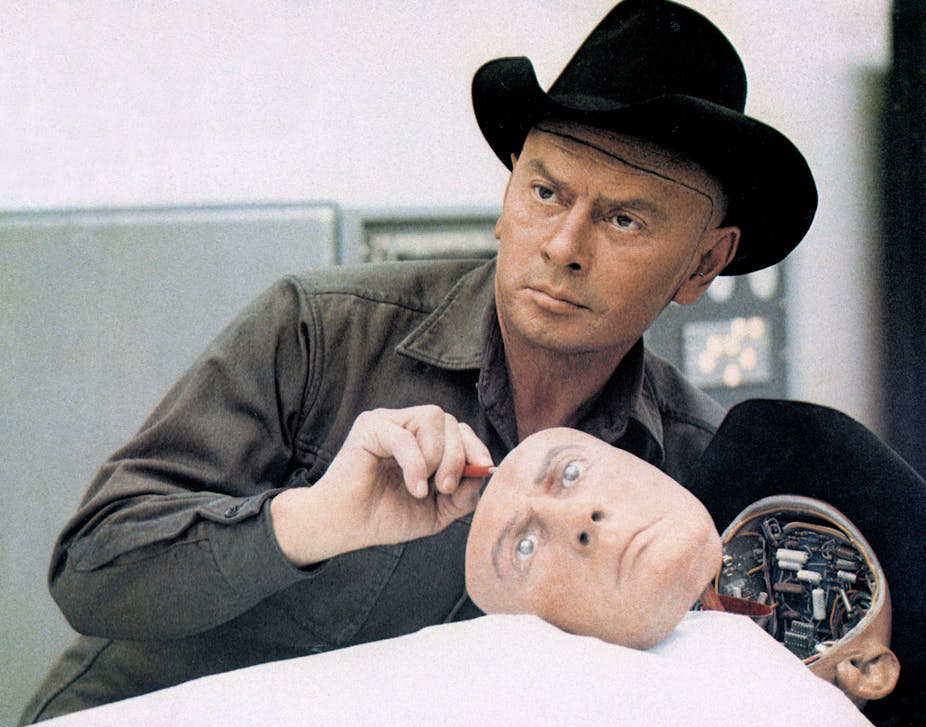Westworld turns 50 on November 21. Director Michael Crichton’s cautionary tale showed that high-concept feature films could act as a vehicle for social commentary. Westworld blended cinematic genres, taking into account the audience’s existing knowledge of well-worn narrative conventions and playfully subverting them as the fantasy turns to nightmare.
The film centres on a theme park where visitors, in this case the protagonists Peter (Richard Benjamin) and John (James Brolin), can enter a simulated fantasy world – Pompeii, Medieval Europe, or the Old West. Once there, they can live out their wildest fantasies. They can even have sex with the synthetic playthings that populate the worlds.
This sinister idea went on to be explored further in later films such as The Stepford Wives (1975 & 2004), A.I. Artificial Intelligence (2001) and Ex Machina (2014).
Of course, it all goes terribly wrong when a computer virus overruns the park and the androids become unbound from the safety protocols that have been encoded into them. The resultant horror climaxes with Peter being stalked through the park by the menacing gunslinger (Yul Brynner).
The film isn’t perfect. Westworld was Michael Crichton’s feature directorial debut, and it shows – as does the tight shooting schedule and frugal budget imposed by MGM. The studio was notorious at the time for mishandling projects and their directors.
Compared to some of the other notable films released that year, such as William Friedkin’s masterful The Exorcist, Nicolas Roeg’s terrifying Don’t Look Now and Clint Eastwood’s assured High Plains Drifter, Westworld has a B-movie aesthetic.
This is, though, elevated by a towering performance from Brynner, and the high-concept approach that later came to dominate the Hollywood system. The film also provided fruitful inspiration for an ambitious HBO adaptation in 2016.
Read more: Why watching Westworld's robots should make us question ourselves
Genre blending and bending
Westworld successfully blended science fiction with other genres. In this sense, it was a pioneering film, which made the most of its limitations due to the hugely influential imagination of Crichton and a postmodern masterstroke of the casting and performance of Brynner.
Today’s cinema is saturated with meta-textual references – moments when a film makes a critical commentary on itself or another movie. This was typified by Michael Keaton’s recent reprisal of his role as Batman in The Flash. But when Westworld was released, such creative choices were novel and fresh.

Bynner’s android gunslinger wears a costume almost identical to the one he donned for his role in The Magnificent Seven (1961). The choice adds dramatically to the thematic concerns of the film – the saturation of consumer culture and the postmodern bent towards repetition, simulation and cliche.
The simulated scenes in the theme park itself are built around cliched movie moments. The three settings which high-paying customers can enter represent film genres: The Medieval simulation, the “swords and sandals” recreation of the Roman Empire and the titular western.
When Westworld was released, each of these genres (the Medieval history, the Roman epic and the western) were already past their heyday, both in terms of popularity and reliability at the box office. Using them furthered the film’s comment on contemporary Hollywood – that it had run out of original ideas and was simply cashing in on nostalgia.
Westworld and AI
Though other films, like Stanley Kubrick’s 2001: A Space Odyssey (1968), were exploring the concept of nascent AI around this time, Westworld arguably did so in the most accessible style. And its legacy in doing so is clear in subsequent films, such as The Terminator (1984), The Matrix (1999) and recently in M3GAN (2023).
Crichton later revisited the notion of a theme park turning perilous due to the Promethean human instinct in his novel, Jurassic Park in 1990. Steven Spielberg’s adaptation remains one of the high points in American action-adventure cinema.
The fascinating scenarios Michael Crichton explored in his work successfully embodied the societal anxieties and technophobia of the 1970s. And in Westworld, he demonstrated a flair for capturing such fears in visual set pieces. This is no more evident than in the iconic, uncanny image of Yul Brynner’s deadly, sentient killer cowboy. Fifty years on, it remains one of the most memorable images in science fiction cinematic history.

Looking for something good? Cut through the noise with a carefully curated selection of the latest releases, live events and exhibitions, straight to your inbox every fortnight, on Fridays. Sign up here.

